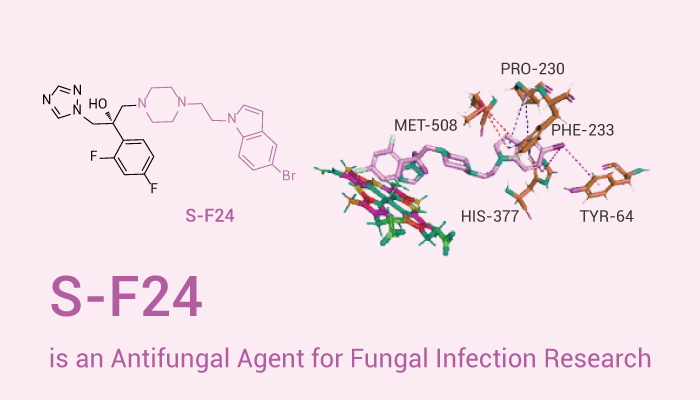For individuals with weakened immune systems, fungal infections with high mortality rates could be life-threatening. Although there are many antifungal agents already, drug resistance is still a critical issue. For example, some “superbug fungus” (such as Candida auris) are resistant to many antifungal agents. Noticeably, fungal cells rely on ergosterol as their membrane sterol, and CYP51 is a critical enzyme in ergosterol biosynthesis. Therefore, CYP51 inhibitors are potential antifungal agents by inhibiting ergosterol biosynthesis. What’s more, S-F24 is a novel triazole antifungal agent, and has better or comparable to clinically used azoles.

S-F24, a CYP3A4 inhibitor, is a broad-spectrum antifungal agent.
In vitro, S-F24 inhibits C. albicans CYP3A4 with an IC50 value of 0.4 μM. Besides, in mammalian cells, S-F24 (10-30 μM, 48 h) displays a good safety profile, and also has high selectivity and low hemolytic effects. Importantly, S-F24 has low tendency to induce drug resistance. By inhibiting CYP3A4, S-F24 (0.004 μg/mL, 16 h) induces the accumulation of lanosterol, and inhibits ergosterol biosynthesis to 92.03% in C. albicans strain (SC5314).
Moreover, S-F24 also shows antifungal effect in vivo. Specifically, S-F24 (1, 5 mg/kg, i.p., 5 days, daily) is effective against fungal infection in female IRC mice infected with C. albicans (SC5314) or A. fumigatus (CGMCC3.7795). In this model, S-F24 prolongs the survival time of infected mice. The median survival time (MST) increases to 6 days. Apart from this, S-F24 (1, 5 mg/kg, i.p.) shows antifungal activity in multi-resistant C. albicans 24D strain. It proves that S-F24 is effective against azole-resistant strains. In addition to invasive infections, S-F24 (0.5 and 1.0 mg/kg/day, 100 μL) is also effective against C. albicans skin infections in ICR mice.
Above all, S-F24 is a potent a CYP3A4 inhibitor, and has broad-spectrum antifungal activity in vitro and in vivo. In addition, S-F24 is effective in both invasive and superficial infections, and has good safety profile.
References:
[1] Zhu P, et al. J Med Chem. 2023 Jun 8;66(11):7497-7515.